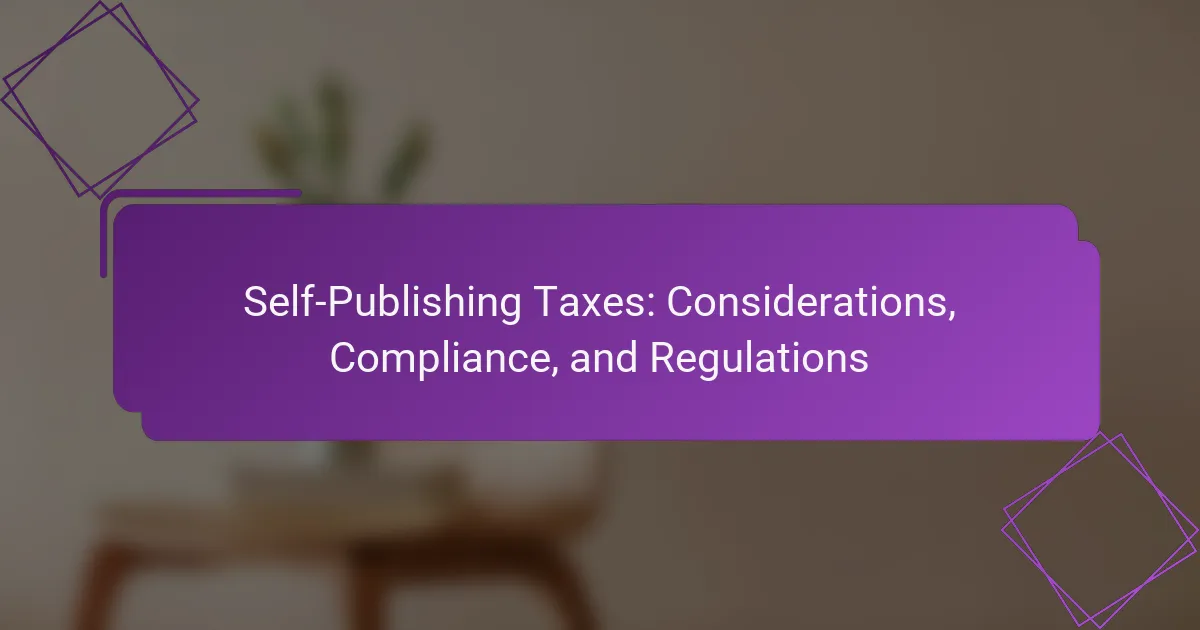Self-publishing can be a rewarding yet complex journey, with various costs to consider, including editing, cover design, and marketing. By understanding these expenses and creating a detailed budget, authors can navigate the process more effectively and avoid unexpected financial pitfalls. Additionally, exploring funding options such as crowdfunding and grants can provide the necessary support to bring your book to life.
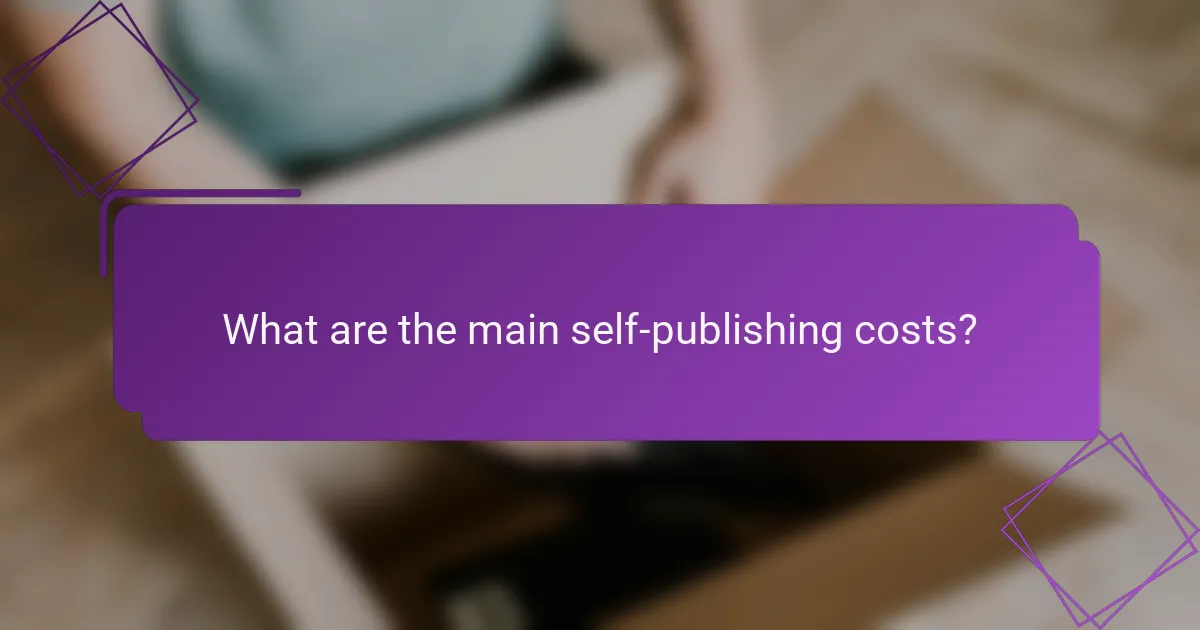
What are the main self-publishing costs?
The primary costs associated with self-publishing include editing, cover design, printing, distribution, marketing, and registration fees. Understanding these expenses helps authors budget effectively and make informed decisions about their publishing journey.
Editing and proofreading expenses
Editing and proofreading are crucial for ensuring the quality of your manuscript. Costs can vary widely, typically ranging from a few hundred to several thousand dollars, depending on the length of the book and the level of editing required.
Consider hiring a professional editor who specializes in your genre for the best results. Be wary of choosing the cheapest option, as quality editing can significantly impact your book’s reception.
Cover design costs
A professional cover design is essential for attracting readers. Prices for cover design can range from $100 to over $1,500, depending on the designer’s experience and the complexity of the artwork.
Investing in a high-quality cover is crucial, as it often influences a potential reader’s first impression. Look for designers with a portfolio that aligns with your book’s genre.
Printing and distribution fees
Printing and distribution costs can vary based on the format (e.g., paperback, hardcover, eBook) and the platform you choose. Print-on-demand services typically charge per book printed, while bulk printing may offer lower per-unit costs.
Be sure to factor in distribution fees, which can include costs for listing your book on platforms like Amazon or IngramSpark. These fees can range from a few dollars to a percentage of your sales.
Marketing and promotion budgets
Marketing is essential for reaching your target audience and can range from minimal to substantial investments. A basic marketing budget might include social media ads, book launch events, and promotional materials, totaling anywhere from a few hundred to several thousand dollars.
Consider allocating a portion of your budget to online advertising and author website development. Effective marketing can significantly boost your book’s visibility and sales.
ISBN and copyright registration
Obtaining an ISBN (International Standard Book Number) is necessary for selling your book through retailers. Prices for ISBNs can range from $125 for a single number to lower rates for bulk purchases.
Copyright registration is also advisable to protect your intellectual property. In the U.S., this typically costs around $45 to $65. Ensure you complete these registrations to safeguard your work against unauthorized use.
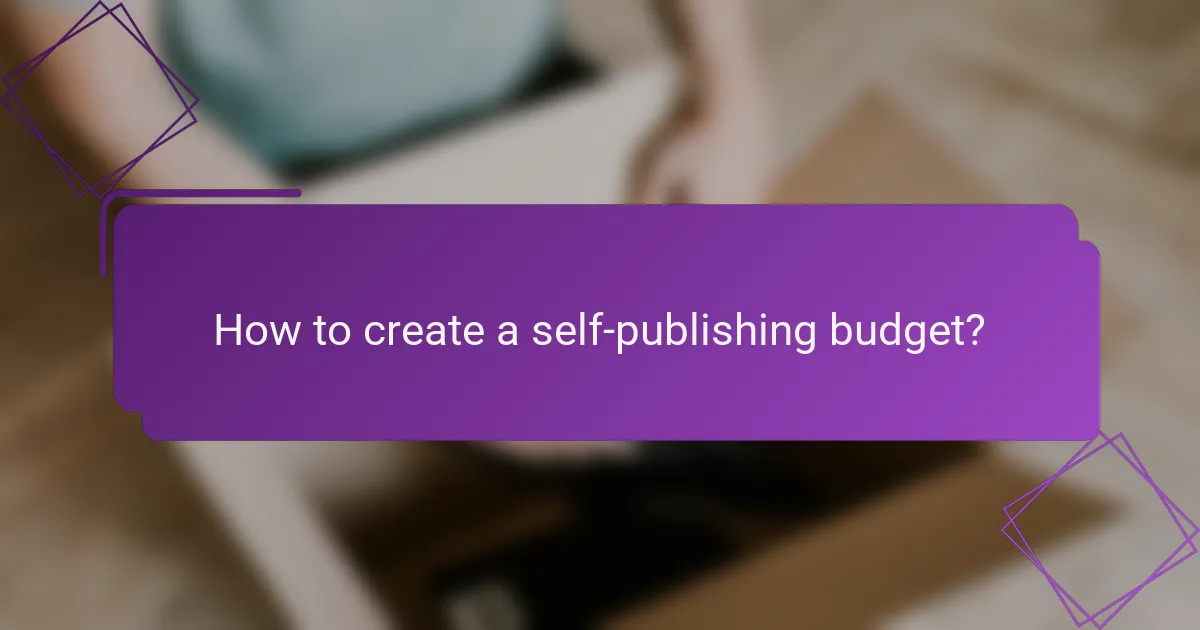
How to create a self-publishing budget?
Creating a self-publishing budget involves identifying all potential costs associated with publishing your work, from editing to marketing. A well-structured budget helps ensure you allocate sufficient funds for each aspect of the process, minimizing unexpected expenses.
Identify essential expenses
Essential expenses in self-publishing typically include editing, cover design, formatting, and distribution fees. For instance, professional editing can range from a few hundred to several thousand dollars depending on the manuscript’s length and complexity.
Additionally, consider costs for ISBNs, which can be purchased individually or in bulk, and any platform fees for publishing on sites like Amazon or IngramSpark. Understanding these core costs is crucial for establishing a realistic budget.
Estimate variable costs
Variable costs can fluctuate based on your choices and the scope of your project. These may include printing costs for physical copies, which can vary widely based on print quality and volume, as well as costs for promotional materials like bookmarks or posters.
To estimate these expenses, research printing services and gather quotes based on your expected print run. This will help you gauge how much you might spend on these variable elements, ensuring you don’t overlook them in your budget.
Allocate funds for marketing
Marketing is a critical component of self-publishing that requires careful budget allocation. Depending on your strategy, you might spend anywhere from a few hundred to several thousand dollars on online ads, social media promotions, or book launch events.
Consider setting aside a percentage of your total budget specifically for marketing efforts. This ensures you have the resources to effectively promote your book and reach your target audience, which is essential for sales success.
Use budgeting tools like Excel
Using budgeting tools like Excel can streamline the budgeting process for self-publishing. Excel allows you to create detailed spreadsheets to track all your expenses, categorize them, and adjust as needed.
Consider setting up a simple table with categories for fixed and variable costs, along with a column for estimated versus actual expenses. This will help you stay organized and make informed decisions throughout your publishing journey.
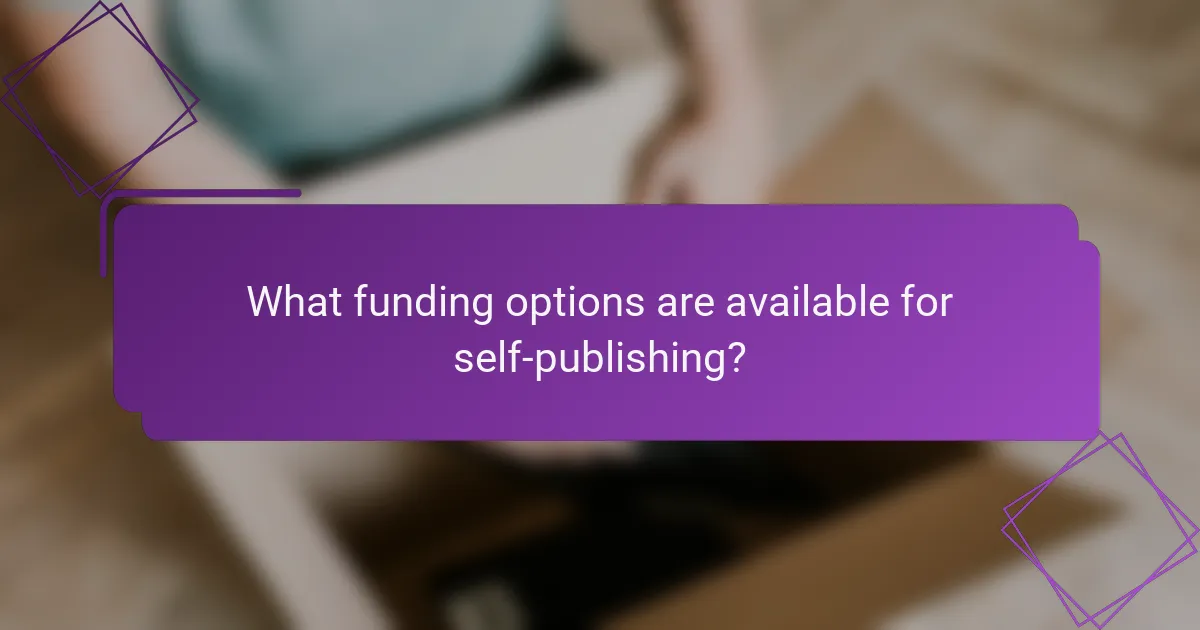
What funding options are available for self-publishing?
Several funding options exist for self-publishing, allowing authors to finance their projects through various means. These include self-funding, crowdfunding, grants, and loans, each with its own advantages and considerations.
Self-funding through savings
Self-funding is often the most straightforward method for authors to finance their publishing endeavors. By using personal savings, authors maintain full control over their work and profits. However, this approach requires careful budgeting to ensure that all expenses, such as editing, design, and marketing, are covered.
Consider setting a specific budget for each aspect of the publishing process. For example, allocate funds for professional editing (which can range from a few hundred to several thousand dollars) and cover printing costs, which can vary based on the format and quantity of books produced.
Crowdfunding platforms like Kickstarter
Crowdfunding platforms, such as Kickstarter and Indiegogo, allow authors to raise funds by soliciting small contributions from a large number of people. This method not only provides financial support but also helps gauge interest in the book before its release. Successful campaigns often offer rewards to backers, such as signed copies or exclusive content.
When planning a crowdfunding campaign, set a realistic funding goal based on your budget and timeline. Promote your campaign through social media and author networks to reach potential backers. Keep in mind that these platforms typically charge a percentage of the funds raised, so factor this into your budget.
Grants for independent authors
Various organizations and foundations offer grants specifically for independent authors. These grants can provide financial assistance for writing, publishing, and marketing projects. Researching and applying for these grants can be time-consuming but may yield significant funding without the need for repayment.
Check local arts councils, literary organizations, and nonprofit foundations for available grants. Each grant will have specific eligibility criteria and application processes, so ensure you meet the requirements and submit all necessary documentation.
Loans and credit options
Loans and credit options, such as personal loans or credit cards, can help authors cover upfront costs associated with self-publishing. While this can provide immediate funding, it is essential to consider the interest rates and repayment terms to avoid financial strain.
Before taking out a loan, calculate the total costs of your project and ensure you have a plan for repayment. Look for loans with favorable terms and consider using credit responsibly to avoid accumulating high-interest debt. Always have a clear strategy for how the investment will generate returns through book sales.
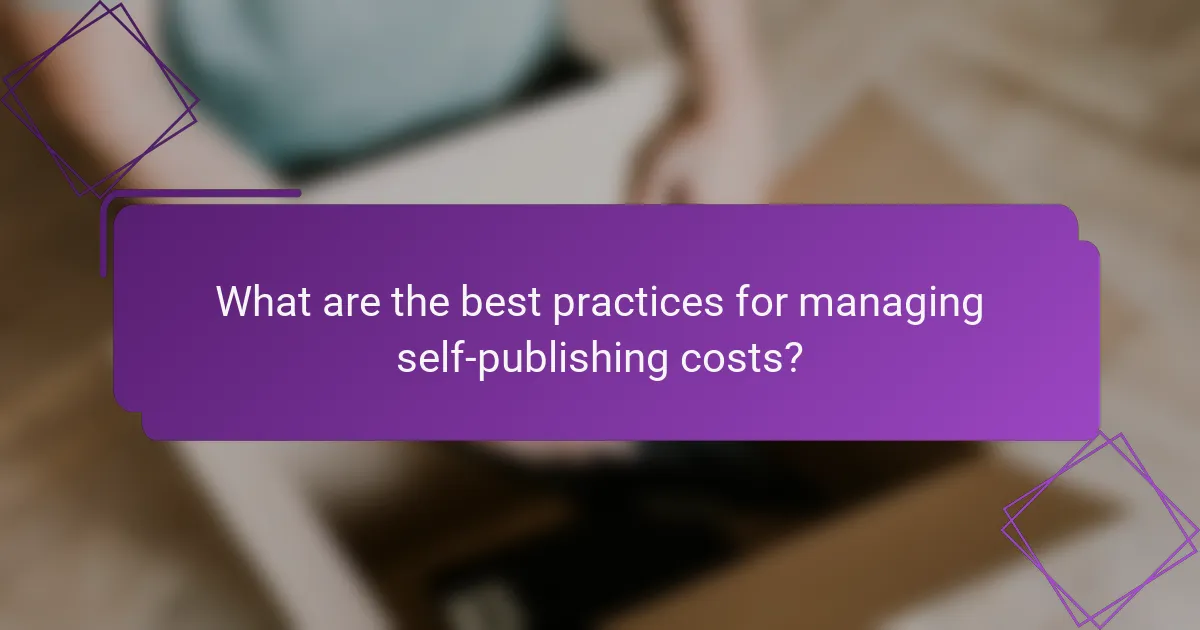
What are the best practices for managing self-publishing costs?
Managing self-publishing costs effectively involves careful planning and strategic decision-making. By tracking expenses, negotiating with service providers, and utilizing free resources, authors can significantly reduce their overall financial burden.
Track expenses meticulously
Keeping a detailed record of all expenses is crucial for managing self-publishing costs. Use spreadsheets or budgeting apps to categorize spending on editing, cover design, marketing, and distribution. This will help you identify areas where you can cut costs or need to allocate more funds.
Consider setting a monthly budget for each category and regularly reviewing your spending against these limits. This practice not only keeps you accountable but also helps in forecasting future expenses more accurately.
Negotiate with service providers
Negotiation can lead to significant savings when working with freelancers or service providers. Don’t hesitate to discuss pricing and ask for discounts, especially if you are committing to multiple services or referrals. Many professionals are willing to offer lower rates to secure long-term clients.
Additionally, consider comparing quotes from different providers. This not only gives you leverage in negotiations but also helps you find the best quality for your budget. Aim for a balance between cost and quality to ensure your book meets industry standards.
Utilize free resources and tools
There are numerous free resources available that can help reduce self-publishing costs. Websites like Canva offer free design tools for creating book covers, while platforms like Draft2Digital provide free distribution services. Take advantage of these tools to minimize expenses without sacrificing quality.
Furthermore, consider joining online writing communities or local author groups. These networks often share valuable resources, such as free workshops, editing services, or marketing advice, which can help you save money while enhancing your self-publishing journey.
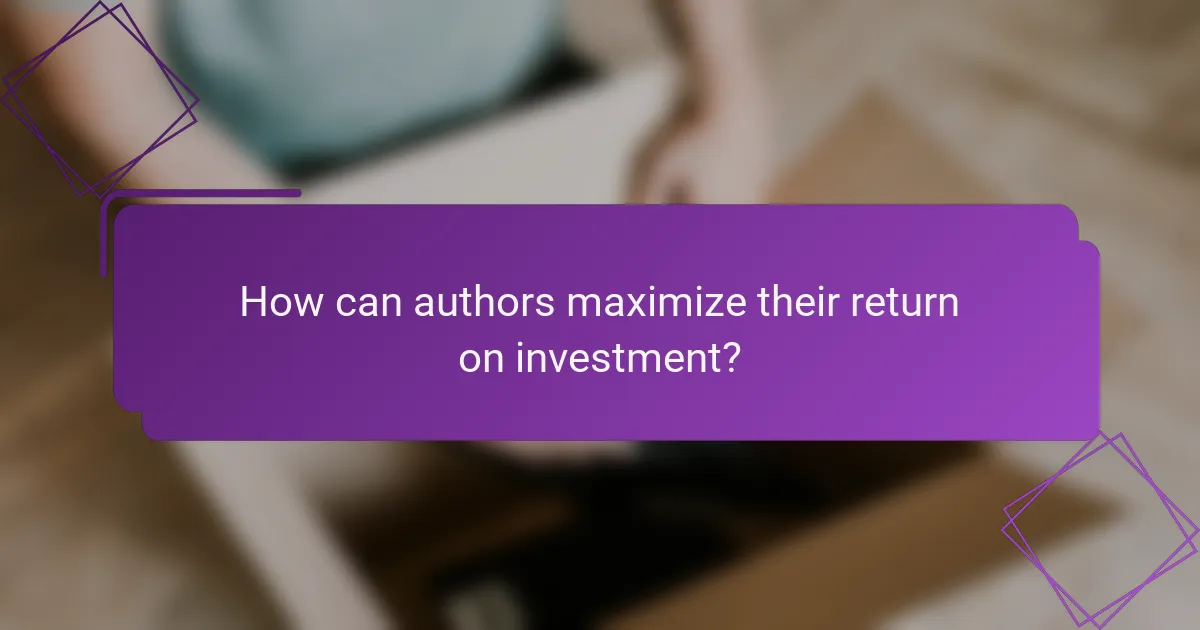
How can authors maximize their return on investment?
Authors can maximize their return on investment by strategically targeting their audience and effectively promoting their work. Focusing on niche markets and leveraging social media can significantly enhance visibility and sales potential.
Focus on niche markets
Identifying and targeting niche markets allows authors to cater to specific interests, which can lead to higher engagement and sales. For instance, instead of writing broadly about romance, an author might focus on historical romance set in a particular era, attracting a dedicated readership.
To effectively reach niche audiences, authors should conduct market research to understand their readers’ preferences and pain points. This can involve exploring online forums, social media groups, and book clubs related to the niche.
Consider creating tailored marketing materials that resonate with the niche audience. This could include specialized book covers, targeted ads, or collaborations with influencers in that specific genre.
Leverage social media for promotion
Social media platforms are powerful tools for authors to promote their work and connect with readers. By sharing engaging content, such as behind-the-scenes looks at the writing process or snippets from upcoming books, authors can build a loyal following.
Choosing the right platforms is crucial; for instance, Instagram and TikTok are effective for visual storytelling, while Twitter can be useful for engaging in conversations and sharing updates. Authors should focus on platforms where their target audience is most active.
Consistency is key in social media marketing. Authors should develop a content calendar to regularly post updates, interact with followers, and participate in relevant discussions. This ongoing engagement can help maintain interest and drive book sales over time.



